Taxonomic Reinstatement of the Endemic Chinese Species Iris thoroldii (Iridaceae) from I. potaninii and Reassessment of I. zhaoana
Abstract
:1. Introduction
2. Materials and Methods
2.1. Study Material
2.2. Morphological Data
2.3. Taxonomy and Distribution
3. Results
4. Discussion
4.1. Taxonomic Delineation between Iris thoroldii and I. potaninii
4.2. Taxonomic Treatment
4.3. Notes on the Distribution and Habitat
5. Conclusions
Supplementary Materials
Funding
Data Availability Statement
Acknowledgments
Conflicts of Interest
References
- Goldblatt, P. Phylogeny and classification of the Iridaceae and the relationships of Iris. Ann. Bot. N. Ser. 2000, 58, 13–28. [Google Scholar] [CrossRef]
- Waddick, J.W.; Zhao, Y.-T. Iris of China; Timber Press: Portland, OR, USA, 1992. [Google Scholar]
- Zhao, Y.-T.; Noltie, H.J.; Mathew, B. Iridaceae. In Flora of China; Wu, Z.-Y., Raven, P.H., Eds.; Science Press: Beijing, China; Missouri Botanical Garden Press: St. Louis, MO, USA, 2000; Volume 24, pp. 297–313. [Google Scholar]
- Boltenkov, E.V.; Artyukova, E.V.; Kozyrenko, M.M.; Trias-Blasi, A. Iris tibetica, a new combination in I. ser. Lacteae (Iridaceae) from China: Evidence from morphological and chloroplast DNA analyses. Phytotaxa 2018, 338, 223–240. [Google Scholar] [CrossRef]
- Boltenkov, E.; Artyukova, E.; Kozyrenko, M.; Erst, A.; Trias-Blasi, A. Iris sanguinea is conspecific with I. sibirica (Iridaceae) according to morphology and plastid DNA sequence data. PeerJ 2020, 8, e10088. [Google Scholar] [CrossRef] [PubMed]
- Wilson, C.A. Two new species in Iris series Chinenses (Iridaceae) from south-central China. PhytoKeys 2020, 161, 40–60. [Google Scholar] [CrossRef]
- Boltenkov, E.V.; Artyukova, E.V.; Trias-Blasi, A. Taxonomic composition of Iris subser. Chrysographes (Iridaceae) inferred from chloroplast DNA and morphological analyses. Plants 2021, 10, 2232. [Google Scholar] [CrossRef] [PubMed]
- Boltenkov, E.V. Resolving the puzzle of Iris maackii (Iridaceae): A morphological insight into its taxonomy. Plants 2023, 12, 3349. [Google Scholar] [CrossRef] [PubMed]
- Boltenkov, E.V.; Artyukova, E.V. New approach to the systematics of the section Psammiris (Iris, Iridaceae): What does chloroplast DNA sequence tell us? Plants 2023, 12, 1254. [Google Scholar] [CrossRef] [PubMed]
- Hemsley, W.B. On two small collections of dried plants from Tibet. J. Linn. Soc. Bot. 1894, 30, 101–140. [Google Scholar] [CrossRef]
- Wang, J.; Gao, Y. Study on the relationship between leaf anatomical structure and drought resistance of four species of Iris. Heilongjiang Agric. Sci. 2008, 5, 101–104. [Google Scholar]
- Oliver, D. Iris thoroldi, Baker. Hooker’s Icon. Pl. Ser. 4 1894, 24, 2302. [Google Scholar]
- Hemsley, W.B. Flora of Tibet or High Asia. J. Linn. Soc. Bot. 1902, 35, 124–265. [Google Scholar] [CrossRef]
- Grubov, V.I. Iridaceae. In Plantae Asiae Centralis; Grubov, V.I., Egorova, T.V., Eds.; Nauka: Leningrad, Russia, 1977; Volume 7, pp. 88–102. [Google Scholar]
- Liu, Y.-H. Flora in Desertis Reipublicae Populorum Sinarum; Science Press: Beijing, China, 1985; Volume 1, Available online: https://www.biodiversitylibrary.org/bibliography/52465 (accessed on 23 October 2023).
- Dykes, W.R. The Genus Iris; Cambridge University Press: Cambridge, UK, 1913. [Google Scholar] [CrossRef]
- Dykes, W.R. A Handbook of Garden Irises; M. Hopkinson & Co.: London, UK, 1924. [Google Scholar] [CrossRef]
- Sand, W.W.A. A study of Pogoniris varieties. Mem. N. Y. Agric. Exp. Stn. 1926, 100, 1–159. [Google Scholar]
- Peckham, E.A.S. Alphabetical Iris Check List; Waverly Press: Baltimore, MD, USA, 1939. [Google Scholar]
- Zhao, Y.-T. Some notes on the genus Iris of China. Acta Phytotax. Sin. 1980, 18, 53–62. Available online: https://www.jse.ac.cn/EN/Y1980/V18/I1/53 (accessed on 23 October 2023).
- Maximowicz, C.J. Diagnoses plantarum novarum asiaticarum, III. Bull. Acad. Imp. Sci. Saint-Pétersbourg 1880, 26, 420–542. [Google Scholar]
- Zhao, Y.-T. Iridaceae. In Flora Xizangica; Wu, C.-Y., Ed.; Science Press: Beijing, China, 1987; Volume 5, pp. 607–623. [Google Scholar]
- Mathew, B. The Iris, 2nd ed.; Timber Press: Portland, OR, USA, 1989. [Google Scholar]
- Service, N. Section Psammiris (Spach) J. Taylor. In A Guide to Species Irises: Their Identification and Cultivation; The Species Group of the British Iris Society, Ed.; Cambridge University Press: Cambridge, UK, 2012; pp. 58–62. [Google Scholar]
- Crespo, M.B.; Alexeeva, N.B.; Xiao, Y.E. Iris zhaoana, a new name for Iris potaninii var. ionantha (I. sect. Pseudoregelia ser. Tigridiae, Iridaceae) from China: Evidence from morphological and plastid DNA data. Phytotaxa 2020, 470, 282–289. [Google Scholar] [CrossRef]
- Catalogue of Life. Available online: https://www.catalogueoflife.org/ (accessed on 23 October 2023).
- Encyclopedia of Life. Available online: https://eol.org/pages/42430800 (accessed on 23 October 2023).
- iNaturalist. Available online: https://www.inaturalist.org/ (accessed on 23 October 2023).
- Leipzig Catalogue of Vascular Plants. Available online: https://lifegate.idiv.de (accessed on 23 October 2023).
- Plantarium. Available online: https://www.plantarium.ru/lang/en/page/view/item/20797.html (accessed on 23 October 2023).
- Plants of the World Online. Available online: https://powo.science.kew.org/ (accessed on 23 October 2023).
- SIGNA. Available online: http://www.signa.org/index.pl?Iris-potaninii (accessed on 23 October 2023).
- The American Iris Society Iris Encyclopedia. Available online: https://wiki.irises.org/Spec/SpecPotaninii (accessed on 23 October 2023).
- The Global Biodiversity Information Facility. Available online: https://www.gbif.org/ (accessed on 23 October 2023).
- The Plant Photo Bank of China. Available online: https://ppbc.iplant.cn/ (accessed on 23 October 2023).
- Tropicos. Available online: https://tropicos.org/name/Search (accessed on 23 October 2023).
- Wikipedia. Available online: https://en.wikipedia.org/wiki/Iris_potaninii (accessed on 23 October 2023).
- World Flora Online. Available online: https://wfoplantlist.org/plant-list (accessed on 23 October 2023).
- World Plants. Available online: https://www.worldplants.de/world-plants-complete-list/complete-plant-list (accessed on 23 October 2023).
- Liu, S.-W. Iridaceae. In Flora Qinghaiica; Liu, S.-W., Ed.; Qinghai People’s Publishing House: Xining, China, 1999; Volume 4, pp. 285–294. [Google Scholar]
- Grey-Wilson, C.; Cribb, P. Guide to the Flowers of Western China; Kew Publishing: Kew, UK, 2011. [Google Scholar]
- Miehe, G.; Bach, K.; Miehe, S.; Kluge, J.; Yongping, Y.; Duo, L.; Co, S.; Wesche, K. Alpine steppe plant communities of the Tibetan highlands. Appl. Veg. Sci. 2011, 14, 547–560. [Google Scholar] [CrossRef]
- Voronin, A.A.; Lepeshkina, L.A.; Klevcova, M.A.; Weiguo, T.; Gou, X.; Fan, H. The Tibetan Plateau as a region-donor plants of exotic species. Int. Res. J. 2016, 4, 25–27. [Google Scholar] [CrossRef]
- Dong, Q.; Guo, X.; Chen, K.; Ren, S.; Muneer, M.A.; Zhang, J.; Li, Y.; Ji, B. Phylogenetic correlation and symbiotic network explain the interdependence between plants and arbuscular mycorrhizal fungi in a Tibetan alpine meadow. Front. Plant Sci. 2021, 12, 804861. [Google Scholar] [CrossRef]
- Weihua, Q.; Kelin, C.; Weiqi, M. A natural wildlife park—An investigation record of Altun Mountain National Nature Reserve in Xinjiang. Life World 2021, 2, 64–83. [Google Scholar]
- Biodiversity of the Hengduan Mountains and Adjacent Areas of South-Central China. Available online: http://hengduan.huh.harvard.edu/fieldnotes (accessed on 23 October 2023).
- Observation.org. Available online: https://observation.org/ (accessed on 23 October 2023).
- Wilson, C.A. Sectional relationships in the Eurasian bearded Iris (subgen. Iris) based on phylogenetic analyses of sequence data. Syst. Bot. 2017, 42, 392–401. [Google Scholar] [CrossRef]
- Index Herbariorum. Available online: https://sweetgum.nybg.org/ih/ (accessed on 23 October 2023).
- Chinese Virtual Herbarium. Available online: https://www.cvh.ac.cn/index.php (accessed on 23 October 2023).
- National Specimen Information Infrastructure. Available online: http://www.nsii.org.cn/2017/home.php (accessed on 23 October 2023).
- Beentje, H. The Kew Plant Clossary; Kew Publishing: Kew, UK, 2012. [Google Scholar]
- Wilson, C.A. Subgeneric classification in Iris re-examined using chloroplast sequence data. Taxon 2011, 60, 27–35. [Google Scholar] [CrossRef]
- Turland, N.J.; Wiersema, J.H.; Barrie, F.R.; Greuter, W.; Hawksworth, D.L.; Herendeen, P.S.; Knapp, S.; Kusber, W.-H.; Li, D.-Z.; Marhold, K.; et al. (Eds.) International Code of Nomenclature for Algae, Fungi, and Plants (Shenzhen Code) Adopted by the Nineteenth International Botanical Congress Shenzhen, China, July 2017 [Regnum Vegetabile Volume 159]; Koeltz Botanical Books: Glashütten, Germany, 2018. [Google Scholar] [CrossRef]
- International Plant Names Index. Available online: https://www.ipni.org/ (accessed on 23 October 2023).
- Brummitt, R.K. Species, subspecies, variety or form—An old problem revisited in tropical African Protea. Mitt. Inst. Allg. Bot. Hamburg 1990, 23b, 677–682. [Google Scholar]
- Bower, H. A journey across Tibet. Geogr. J. 1893, 1, 385–408. [Google Scholar] [CrossRef]
- Letter from, W.G. Thorold to the Royal Botanic Gardens, Kew; from 44 Eardley Crescent, Earls Court, [London, England]; 16 July 1892. Available online: https://plants.jstor.org/stable/10.5555/al.ap.visual.kdcas5936 (accessed on 23 October 2023).
- Przewalski, N.M. Fourth Trip to Central Asia; From Kyakhta to the Sources of the Yellow River; Exploring the Northern Edge of Tibet and the Path Through the Lop Nur Tarim Basin; Printing House of V.S. Balashev: St. Petersburg, Russia, 1888. [Google Scholar]
- Wright, C.H. Irideae. J. Linn. Soc. Bot. 1903, 36, 80–86. [Google Scholar]
- Diels, L. Botanische Ergebnisse. In Wissenschaftliche Ergebnisse der Expedition Filchner nach China und Tibet; Filchner, W., Ed.; Ernst Siegfried Mittler und Sohn: Berlin, Germany, 1908; Volume 10, pp. 245–273. [Google Scholar]
- Dykes, W.R. Iris nepalensis and its neighbours. Gard. Chron. Ser. 3 1910, 48, 241. [Google Scholar]
- Dykes, W.R. Some Tibetian irises. Gard. Chron. Ser. 3 1916, 59, 194–195. [Google Scholar]
- Li, X.-Y. Iridaceae. In Flora Xinjiangensis; Commissione Redactorum Florae Xinjiangensis, Ed.; Xinjiang Science & Technology & Hygiene Publishing House: Urumqi, China, 1996; Volume 6, pp. 562–579. [Google Scholar]
- Zhao, Y.-T. The wild irises of China. In Proceedings of the International Symposium on Iris, Celebrating the 50th Anniversary of the New Zealand Iris Society, Tauranga, New Zealand, 2–6 November 2000; pp. 39–43. [Google Scholar]
- Fu, L.; Hong, T. Higher Plants of China; Qingdao Publishing House: Qingdao, China, 2002; Volume 13. [Google Scholar]
- Wu, Z.-Y.; Raven, P.H. Flora of China Illustrations; Science Press: Beijing, China; Missouri Botanical Garden Press: St. Louis, MO, USA, 2002; Volume 24, p. 358. [Google Scholar]
- Peijun, Y. Phylogeography of Iris potaninii Maxim. Master’s Thesis, Northeast Normal University, Changchun, China, 2020. [Google Scholar] [CrossRef]
- Guo, B. 青海经济植物志 [Qinghai Economical Botany]; Qinghai People’s Publishing House: Xining, China, 1987; Available online: https://www.biodiversitylibrary.org/bibliography/53343 (accessed on 23 October 2023).
- Stainton, A. Flowers of Himalaya: A Supplement; Oxford University Press: Delhi, India, 1988. [Google Scholar]
- Chen, C.-G.; Fischer, A.; Herrmann, W.; Yang, P.-H. Flora of the Loess Plateau in Central China: A Field Guide; IHW-Verlag: Munich, Germany, 2007. [Google Scholar]
- Boltenkov, E.V.; Menshakova, M.Y.; Gainanova, R.I.; Rumjantseva, Z.Y. The first record of Iris setosa (Iridaceae) in Europe. Phytotaxa 2020, 437, 32–38. [Google Scholar] [CrossRef]
- Liao, J.; Lu, M.; Gu, H.; Luo, B.; Jing, X.; He, J.-S. Warming-induced shifts on Tibetan Plateau: The overlooked ants and their ecological impacts. Landsc. Ecol. 2023. [Google Scholar] [CrossRef]
- Zhu, H.; Liu, C.; Qian, H. Pharmaceutical potential of high-altitude plants for fatigue-related disorders: A review. Plants 2022, 11, 2004. [Google Scholar] [CrossRef] [PubMed]
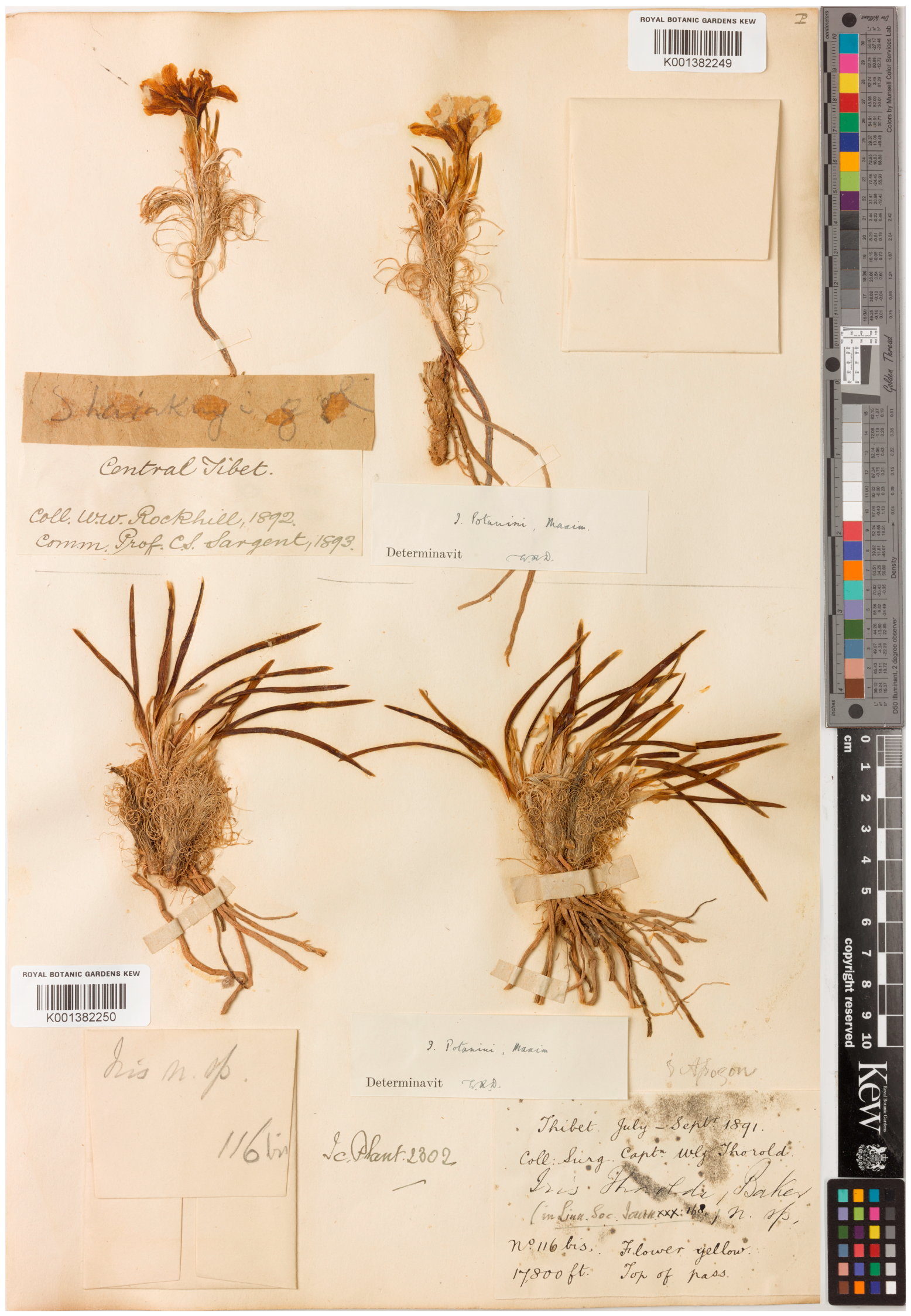
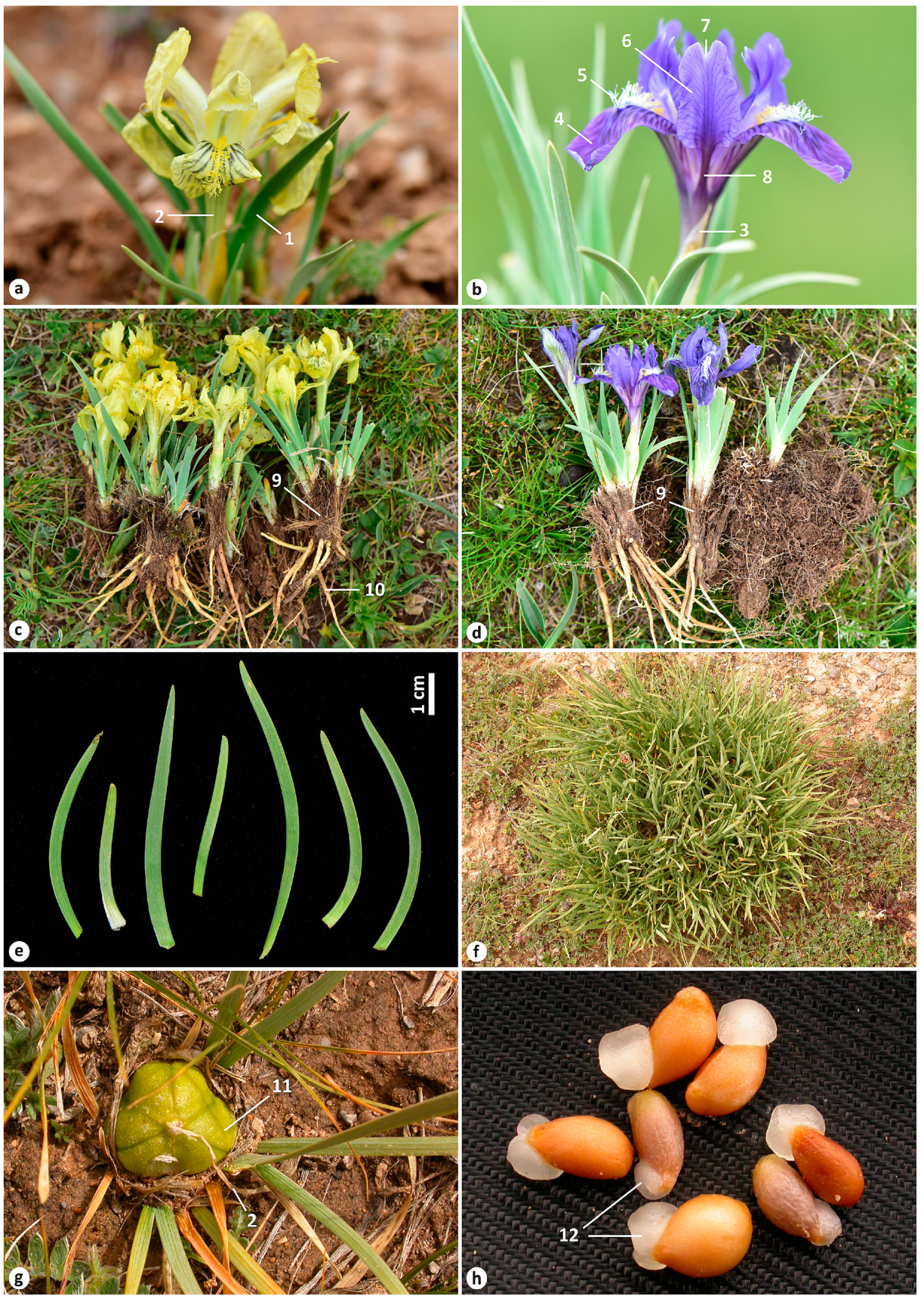
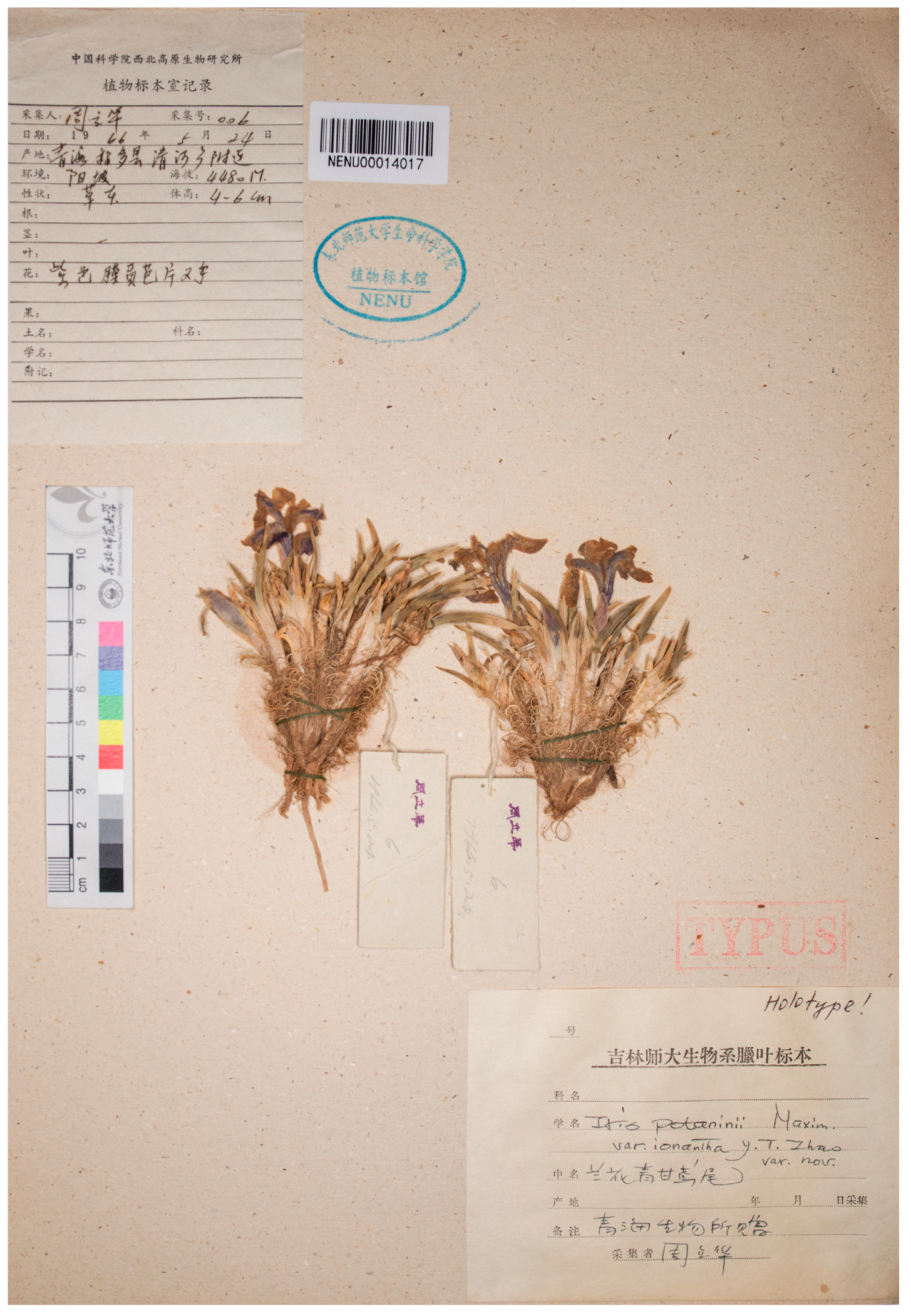
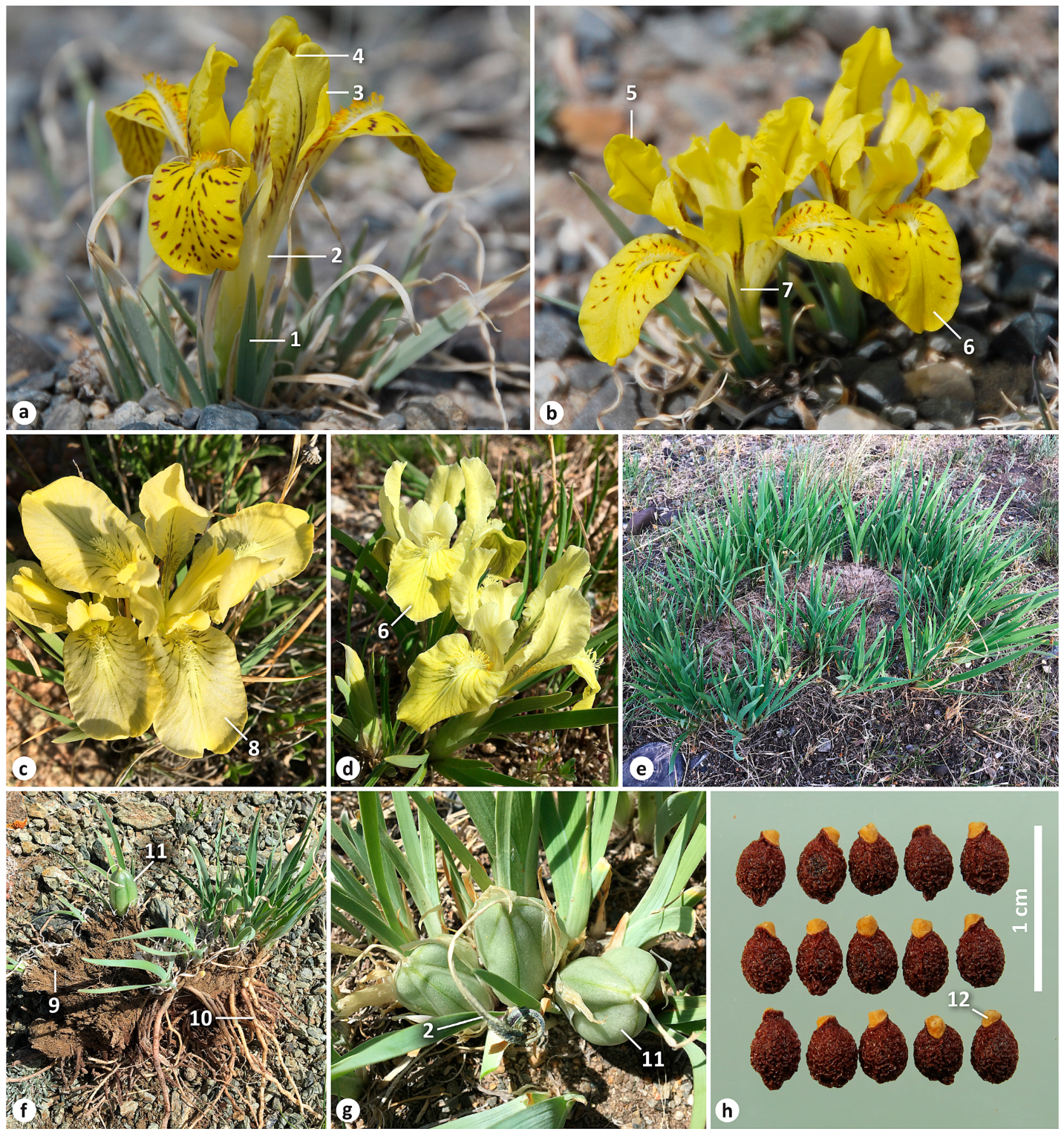
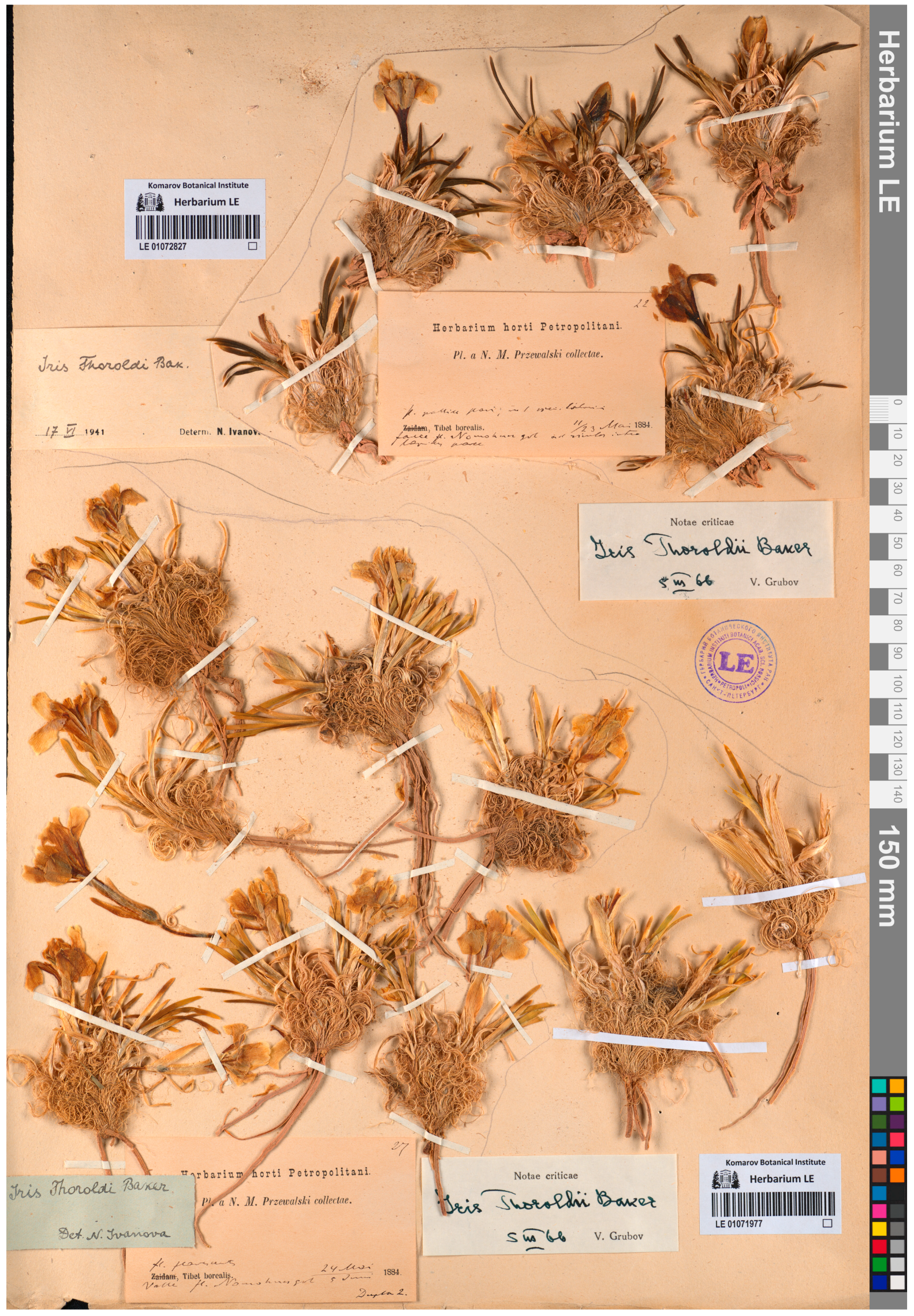
| No. | Characters | I. thoroldii | I. potaninii |
|---|---|---|---|
| 1 | Rhizome shape | Shortened, vertical | Shortened, horizontal, or vertical |
| 2 | Adventitious root shape | Contractile | Contractile |
| 3 | Rosette leaf shape | Narrow-linear | Narrow-linear |
| 4 | Rosette leaf apex shape | Obtuse or acute | Narrowly acute |
| 5 | Rosette leaf texture | Soft | Tough |
| 6 | Rosette leaf length | 11.5 (4.5–28) | 13 (5–29) |
| 7 | Rosette leaf width | 0.3 (0.15–0.5) | 0.3 (0.1–0.5) |
| 8 | Leaf remnants’ shape | Straight in wild, curled in dry | Straight |
| 9 | Leaf remnants’ height | 4.8 (1.5–12) | 2.8 (1–5) |
| 10 | Stem height | 3.6 (1.5–6) | 1.5 (0.5–2.5) |
| 11 | Number of stem leaves | 2 | 2–3 |
| 12 | Stem leaf length | 3.6 (2–5.6) | 4.5 (2.5–6) |
| 13 | Stem leaf shape | Lanceolate, apex acute | Lanceolate, apex acuminate |
| 14 | Number of bracts | 2 | 2 |
| 15 | Bract shape | Lanceolate, apex acute | Lanceolate, apex acute |
| 16 | Bract texture | Membranous | Membranous |
| 17 | Bract length | 5 (2.2–8.5) | 4.2 (2.5–6) |
| 18 | Pedicel length | 0.7 | 0.1 (0–0.2) |
| 19 | Perianth tube length | 5.3 (2.5–9.2) | 3.3 (1.5–6) |
| 20 | Number of flowers | 1 | 1 |
| 21 | Flower color | Yellow, nearly white, blue, purple, or blue-purple | Yellow, pale yellow |
| 22 | Flower diameter | 3.3 (2.2–5.5) | 3.6 (2–5.5) |
| 23 | Blade of fall shape | Obovate | Lingulate |
| 24 | Fall length | 3 (2.5–4.5) | 3.5 (2–4.5) |
| 25 | Fall width | 1.1 (0.7–1.7) | 1.2 (0.6–1.6) |
| 26 | Standard shape | Oblanceolate | Obovate |
| 27 | Standard length | 2.6 (2–3.2) | 3 (2.4–3.5) |
| 28 | Standard width | 0.8 (0.5–1.2) | 1 (0.7–1.2) |
| 29 | Fruit shape | Elliptical or globose | Elliptical |
| 30 | Fruit length | 2.1 (1.5–3) | 2.8 (2–4) |
| 31 | Fruit width | 1.5 (1–2) | 1.5 (0.8–2) |
| 32 | Seed shape | Pyriform, with large white aril | Elliptical, with small beige aril |
| 33 | Seed color | Dark brown | Brown or dark brown |
| 34 | Seed length | 0.4 (0.4–0.5) | 0.4 (0.3–0.5) |
| 35 | Seed width | 0.2 (0.2–0.3) | 0.3 (0.2–0.3) |
Disclaimer/Publisher’s Note: The statements, opinions and data contained in all publications are solely those of the individual author(s) and contributor(s) and not of MDPI and/or the editor(s). MDPI and/or the editor(s) disclaim responsibility for any injury to people or property resulting from any ideas, methods, instructions or products referred to in the content. |
© 2023 by the author. Licensee MDPI, Basel, Switzerland. This article is an open access article distributed under the terms and conditions of the Creative Commons Attribution (CC BY) license (https://creativecommons.org/licenses/by/4.0/).
Share and Cite
Boltenkov, E.V. Taxonomic Reinstatement of the Endemic Chinese Species Iris thoroldii (Iridaceae) from I. potaninii and Reassessment of I. zhaoana. Plants 2023, 12, 3879. https://doi.org/10.3390/plants12223879
Boltenkov EV. Taxonomic Reinstatement of the Endemic Chinese Species Iris thoroldii (Iridaceae) from I. potaninii and Reassessment of I. zhaoana. Plants. 2023; 12(22):3879. https://doi.org/10.3390/plants12223879
Chicago/Turabian StyleBoltenkov, Eugeny V. 2023. "Taxonomic Reinstatement of the Endemic Chinese Species Iris thoroldii (Iridaceae) from I. potaninii and Reassessment of I. zhaoana" Plants 12, no. 22: 3879. https://doi.org/10.3390/plants12223879
APA StyleBoltenkov, E. V. (2023). Taxonomic Reinstatement of the Endemic Chinese Species Iris thoroldii (Iridaceae) from I. potaninii and Reassessment of I. zhaoana. Plants, 12(22), 3879. https://doi.org/10.3390/plants12223879






